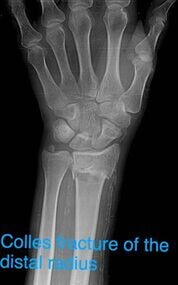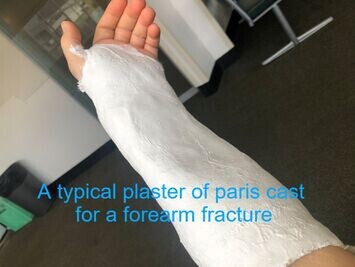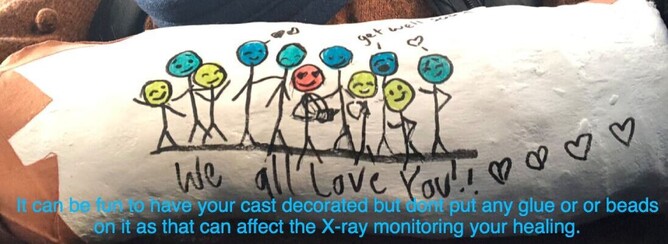BROKEN ARM OR LEG
If you suspect you have broken your arm or leg, you need to seek medical attention immediately and follow all medical advice, including immobilisation of the bone so it can heal. Forearm bones take around six weeks in a cast, then it can be 12 weeks or even a year before the bones are back to full strength. The femur (thigh bone) takes the longest time to heal as it is the largest bone in your body.
The five stages of fracture healing:
Hematoma Formation (Days 1 to 5)
Fibrocartilaginous Callus Formation (Days 5 to 11)
Bony Callus Formation (Days 11 to 28)
Bone Remodelling (Day 18 onwards, lasting months to years)
Initially it may still be painful, taking paracetamol is helpful. Make sure you drink plenty of water with the pain medication to help protect your liver and kidneys.
During the time of wearing a cast, it is not advisable to drive. There are many activities of daily life which will be more difficult. Aim to accept it is simply this way for a while. Depending on your work you may be able to work part time. Remember that things will take longer to do and be more tricky (and sometimes impossible to achieve!) - be patient and ask for help.
To shower, it is important the cast be kept dry at all times so a plastic bag can be taped to the skin with medical tape. Then aim to keep the arm up above your shoulder level. Washing every area of your body can be tricky so just do your best or get some help!
Sometimes your plaster cast is changed for a lighter fiberglass cast after about three weeks if your bone healing is going well. It's worth asking your orthopedic specialist about this as it is less strain on your neck and shoulder.
Picture
WHAT CAN YOU DO TO GET THE BEST OUTCOME, WHILE YOU ARE IN THE CAST AND HEALING?
Eat nutritious foods three times a day - vegetables and fruits of a range of colours, nuts, and seeds, whole grains, dairy, lean protein.
Avoid alcohol, and keep caffeine and processed foods including refined sugar to a minimum, as these increase inflammation in your body and will reduce your body’s healing ability.
It may be helpful to take supplements such as a good quality Multivitamin, Zinc, vitamin C, Vitamin D, fish oils, calcium, and magnesium. These are important for making healthy cells to help your body tissues heal.
Active movements of your fingers into a gentle fist and open again, 4-5 times a day, roll your shoulders, bend your elbow if you can, and move your neck by turning it one way and then the other as if you are scanning the horizon. Relax one ear towards your shoulder, then the other. Encourage your thumb to move its full range of motion within the limitations of the cast. In a leg cast, wiggle your toes, and move your knee and hip joint a few times every hour if these are available to you. Just because one bone is broken doesn't mean the rest of you need to stop moving. Here is a link to some good shoulder mobility exercises
Work on breathing well - through the nose, slow and low into the abdomen 360 degrees around the lower ribs/belly. Bones like oxygen to heal and all your tissues will benefit. On the breath out you can squeeze all the breath out and feel the connection to your core and pelvic floor muscles as much as possible. Then relax and feel your body breathing in again.
Don't try to lift anything heavy or weight bear on that arm/leg. It needs to heal.
Keep your arm or leg raised so the fracture site is above your heart. This will help reduce inflammation and swelling in your arms, fingers, ankle, foot and toes.
Use ice packs on your arm/leg as frequently as needed to reduce swelling
Rest - it takes energy to heal a bone
Take homeopathic Arnica 200c once a day for 2-3 days after the injury to help reduce swelling and pain
Homeopathic Symphytum (knit bone) can really help with bone healing. Research indicates a dose of 30CH for ten days once the fracture is well aligned. Ideally get some homeopathic advice on how much to take and when for your particular case
Get some exercise ie walking/stationary bike each day to help your circulation and oxygenation
Meditation is a good plan to help your mental health while healing any broken bone.
You may like to do some modified yoga - try a ‘hands free yoga’ session online (check out the link here ). Or a 'Hurt foot yoga' here. Yoga can help you feel more connected with and kind to your body. Some yoga is purely sitting or lying down so with a broken leg you can still do that. Just take it slowly and carefully and listen to your body.
Osteopathic gentle hands on treatment once a week helps your body recover from the tissue restrictions due to the injury, reduce pain and calm your nervous system. This helps increase the blood supply for healing your bone.
Pilates with a physical therapist can help you feel stronger and more balanced in your body.
Hyperbaric oxygen therapy daily to help speed up the bone healing and reduce inflammation.
QRS mat (PEMFs Pulsed electromagnetic Fields) at the ‘Vital - Intense’ setting for 20-40 minutes twice a day for the first 3-4 weeks to assist fracture healing. We have one to rent at City Hyperbaric Wellington - contact us on 044991439 or email here.
It’s an exciting day when you finally get your cast off!
Be prepared for your body part which has been in the cast, looking very different. It may be swollen, thickened, red, irritated and scaly with dry skin. It may also feel sensitive to the touch and very weak. The tissues are likely to be tight. This is because your arm/ hand/leg/foot have not been able to move properly for six weeks and this lack of function affects the structure. Its important to have warm water to wash your skin, dead skin will come off it initially. Be gentle and kind to your skin and it should recover quickly.
You may have some dark hairs growing on your arm, hand or leg where the cast has been - this can be due to the complete lack of light and also the irritation of the cast. Your arm needs fresh air and light each day and these hairs will go away over a number of weeks. As soon as you are out of the cast, you may be able to drive, check with your orthopaedic specialist. It's ideal to see a hand therapist as soon as possible to get you onto the right stretches and exercises and monitor your recovery. You may be given a splint that you can take on and off. This is a great improvement from the cast as it won't be heavy and you will start to be able to do more with your arm and hand. It’s good to wear it when outside the home to prevent accidental injury to your healing arm bones.
You may also get a compression glove or 'Tubi grip' to help reduce the swelling in your hand/arm/foot/leg.
Exercises at this early stage consists of gentle stretches 4-5 times a day. Your muscles and tendons have not moved in a while so take it very carefully. Ideally warm up the tissues with a warm shower/wheat bag/hot water bottle before doing the stretches. When doing the stretches, expect to feel a tightness in your tissues, however if you feel any pain you need to back off and take the stretch much more gently.
Once you have full range of motion back in your hand/wrist or foot/ankle, you can start strengthening. Again take it carefully and be patient. Its better to make small improvements each day rather than overdo it and have a set-back. It is good to have personalised hand therapist/physio/osteopathic advice all through this time if possible.
You may need some further osteopathic treatment at this stage to help your body to heal with optimal alignment, assist the blood supply, calm your nervous system and ease tight tissues as you start to do more movements. Your body may feel quite out of balance and this is normal, however the more you can gently move in a balanced manner, the better for your recovery and feeling good in your body.
Now your bone is healed and your muscles, tendons and ligaments are feeling recovered, you can slowly increase your exercise and use props to support your body so you can move and strengthen your body and return to full health again.
I wrote this article after going through the experience of fracturing my distal radius. I wanted to bring all the tools and information together that I used to return to a fully functioning arm, to benefit others going through this tricky time.
To find out more about the author Dr Melanie Young, Click here








